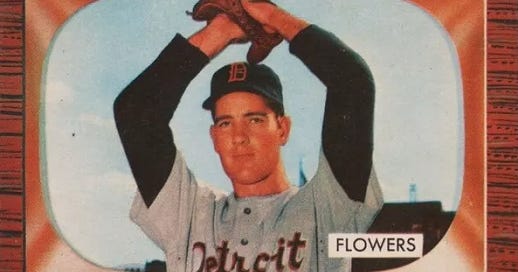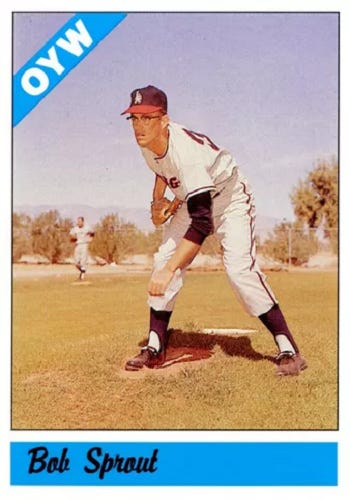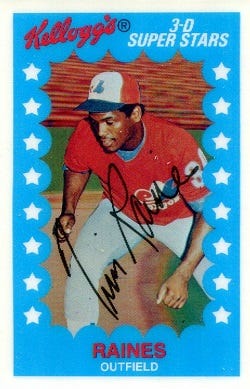Happy Groundhog Day! I’ll be on the road most of today, making the journey to Punxsutawney to throw a blanket over Phil as he emerges from his den — we can’t let that little sucker see his shadow.
Assuming that all goes well, and with pitchers and catchers reporting next week, why, Spring (capital ‘S’) has to be just around the corner. So, with that hopeful thought in mind, below are five baseball cards to get you in the mood for an early Spring.
And if you happen to experience some of the white stuff or subzero temperatures over the next few weeks despite my best efforts, you may need to work on your weather manifestation skills. Don’t blame me, in other words.
1955 Bowman Ben Flowers (#254)
“Winter death and destruction bring spring flowers,” the old saying goes. Or something like that.
For the Detroit Tigers, the winter of 1954-55 brought right-hander Ben Flowers to the team, who plucked him from the Boston Red Sox in the Rule 5 draft. That gave flagging Bowman a chance to scoop Topps by finally featuring Flowers on his first baseball card, despite his having appeared in the majors for the Red Sox in both 1951 and 1953.
And the Tigers were sort of flagging, too, after finishing 68-86-1 and in fifth place in the American League in 1954. Bennett (as Flowers showed up on his Bowman card) appeared in four games for the Tigers in April and May (of course) and posted a 6.00 ERA before getting bounced to the minors.
Detroit traded him to the Cardinals for Bobby Tiefenauer, and Flowers made four appearances for St. Louis down the stretch. For their part, the Tigers finished fifth again, but improved to 79-75.
And in 1956?
Flowers blossomed one more time in the majors, splitting time between the Cards and the Phillies, while the Tigers improved to 82-72-1 while finishing — you guessed it — fifth.
Bowman spent the summer on the scrapheap of hobby history.
1962 Topps Jack Spring (#257)
Jack Spring began his pro career as a starter in the early 1950s but became more of a swingman in the Phillies organization by the middle of the decade. His first cup of coffee early in 1955 consisted of two relief appearances for the Phillies. By the time he made it back to the majors in early 1957, he was with the Red Sox as a Rule 5 pick (after the ‘55 season), but still in the bullpen — a one-inning relief appearance was all she wrote for his big-league Boston career.
Spring then appeared in three games for the 1958 Washington Senators before disappearing into the minors until late in the 1961 season. By then, he was with the expansion Angels. In 18 appearances down the stretch, he made four starts and posted a 3-0 record with a 4.26 ERA.
Not great, but enough for Spring to figure into manager Bill Rigney’s plans for 1962. In fact, Spring made a team-high 57 appearances as the second-year club surprised with an 86-76 record and third-place finish in the A.L.
That same year, collectors got their first look at Spring, who showed up hatless in the classic 1962 Topps woody set.
Spring turned 30 before Opening Day in 1963, though, and his days as a major leaguer were destined to be numbered. After 45 appearances that summer, he made it into 15 games in 1964, split between the Angels, Cubs, and Cardinals. A quick cameo with the Indians in the middle of 1965 gave way to four years back in the minors to wrap up his pro career.
In the end, Spring gave his teams exactly what the winter-worn among us want from the coming season — just a bit of relief.
1967 Topps Curt Flood (#245)
Along with flowers, budding trees, and muddy boots, Spring showers often bring something a bit more intimidating — floods.
And among National League center fielders of the 1960s, few were more intimidating for opposing teams than Curt Flood. The Cardinals superstar could change a game in a lot of ways, from his 200-hit bat to his double-digit power to his 15-steal speed to his Gold Glove defense. It was a combination that made him a deadly, if underappreciated, all-around baseball weapon.
Flood’s 1967 Topps card is clean and graceful, just like his game, and it fell in the middle of a career prime that spanned from 1961 through 1969.
Of course, maybe Flood’s most important contributions to the game came after that age-31 season, when he refused a trade to the Phillies and challenged baseball’s reserve clause. It was a courageous move that cost him his career but helped break ownership’s stranglehold on the game’s riches and set up the flood of free agent money that continues to wash over today’s top players.
1983 Larry Fritsch One-Year Wonders Bob Sprout (#109)
Although the stodgy glasses and close-cropped (or missing) hair suggest a man in his 50s — maybe a coach helping his players limber up — the truth is that Bob Sprout was likely just 19 years old in this pic.
How do I know?
Well, that “OYW” in the corner of his card gives us a hint. That’s short for One-Year Winners, a three-series set of cards produced by Larry Fritsch in the early 1980s and featuring players who were in the majors for just a blink or two. There are 118 cards in all.
As for Sprout, his major league prospects sprouted when the Tigers signed him as an amateur free agent before the 1960 season and then blossomed when the expansion Angels drafted him away that December.
After two seasons in the minors, including a full-summer run at Triple-A Dallas-Fort Worth in 1961, Sprout got his first call-up to the bigs that September. On the 27th, he drew the start at home against the Senators and allowed three runs (two earned) over four innings.
He’d never make it back to the majors again.
But just as Sprout was sprouting as a pro, he left an indelible mark on the game. Hurling for the Decatur Commodores, the Tigers’ Class-D team back in 1960, Sprout struck out 22 batters in a game against the Waterloo Hawks, a Midwest League record that still stands.
That was part of a remarkable first pro season that included 264 strikeouts in 190 innings, along with a 15-7 record, 2.61 ERA, and 14 complete games (five shutouts) in 24 starts among 28 appearances.
That run was easily Sprout’s most successful showing as a pro, but if you’re only going to put up one big season, might as well make it a really big one, huh?
1982 Kellogg’s Tim Raines (#53)
Into each life a little rain must fall, the old saying goes. And, thankfully, into each card collection built through wax packs in the 1980s and 1990s (though “wax” was pretty much extinct most of that latter decade), a few Tim Raines cards must fall.
One of the great leadoff hitters and baserunners in baseball history, Raines and his cards never got quite as much adoration as the late(!), great Rickey Henderson. Heck, it took Rock ten tries to crack the Hall of Fame…but he got there in 2017 by leaping from less than 70% of BBWAA votes in 2016 to 86% that final year.
Raines’ cards never really did catch fire across the hobby at large, either, but they’ve maintained a slow, steady interest among collectors. And there are some real gems in the lot.
So why go with this one that sports an, uh, odd image?
Precisely because it’s an oddball card, for one thing. And it’s a Kellogg’s 3-D Super Stars card for another. And any day that begins with a bowl of cereal and a shiny 1980s baseball card is a good day in my book.
Full of hope…like Spring itself.
And that “uh, odd” shot of Raines just adds to the effect. You don’t have to squint too hard to imagine that he’s about to get down to some garden-planting or snake-in-the-grass stalking instead of trying to get a closer look at the baseline.
Or at least I don’t.
—
There are any number of other players and cards I could have put on this list, but…I didn’t. So feel free to send me your picks, too — I’d love to hear them.
Here’s to a cloudy day in Pennsylvania today and then nothing but blue skies filled with the sound of popping leather and the crack of the bat from there on out.
Thanks for reading.
—Adam









I love all your themed card lists. Great work!
How about Razor Shines? Little bit of a stretch but I think it works…